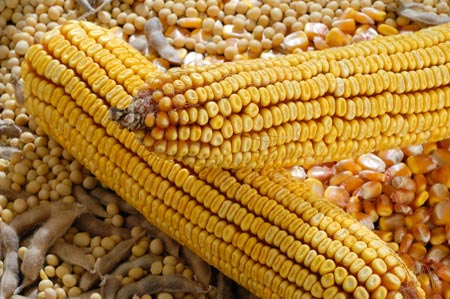 (Agri-View) – Corn trade was soft to start the week, marking new lows before bouncing on June 6.
(Agri-View) – Corn trade was soft to start the week, marking new lows before bouncing on June 6.
July corn was 7 cents lower and December finished the week steady. The weekly progress report listed corn 95 percent planted versus 90 percent last year and a 95 percent normal pace.
The remaining areas to be planted are in northern growing areas and extreme east. Emergence was 80 percent, which is in line with the 5-year average.
The first weekly crop ratings of the year listed corn at 76 percent good to excellent and 2 percent poor to very poor.
If the ratings remain this high yield expectations will be rising closer to 170 bushels per acre by the end of the month. Recent moisture has been widespread helping to ease deficits but the midweek storm probably set back corn over a fairly wide area.
Corn basis has firmed a bit with good demand and slower movement with the break on the board. Ethanol margins remain solid for producers and blenders but a little better for blenders this week. The weekly EIA numbers listed ethanol production 1.19 percent higher and stocks 4.35 percent higher; gasoline demand was down 2 percent so ethanol did retreat.
The weekly export sales were mediocre at 550,700 metric tons of old crop, and 19,600 metric tons; this did not help out the bulls even though corn is approaching oversold conditions.
The weekly export inspections were good at 976,601 metric tons showing the previously sold bushels are moving out of port.
On the July chart we have support at $4.50, which was the high printed around the January report, then $4.44. Chart resistance is $4.68, which is the 10-day moving average. Nearby July corn is now 70 cents off the high printed 4 weeks ago.
The trend is down, but may slow with the market still keeping some weather premium in the market ahead of the mid to late July pollination season.
Hedgers, call us to discuss your individual situation. The monthly USDA Supply and Demand report is the big news this week, it was released on June 11.
Soybeans grind lower
Soybean trade has been active, but mostly lower this week with good crop progress and expected imports limiting upside.
For the week, July beans were down 36 cents lower, and November down 4. Meal was $12.00 lower, while bean oil was 80 points higher. Firm outside markets and a chart turn gave us a big move up in bean oil on Wednesday, which supported beans, but it may be hard for bean oil to hold a higher trend near term.
Although beans are lower on the week they have held up well, which is making late planted acres more likely to end up in soybeans instead of corn.
The July-November spread has been able to print a new high this week up around a $2.80 inverse. Basis has softened a bit this week as processors shift bids to the summer months or November. So it may be hard to not see some profit taking in old crop longs and the bull spreads near term.
The weekly export sales were soft at 41,300 metric tons of old crop, 230,500 metric tons of new crop, product sales were decent at 65,800 of old crop meal, 233,800 of new crop meal, and 5,100 tons of oil.
Crop progress on Monday listed beans at 78 percent planted, 8 percent ahead of average, with emergence at 50 percent, 5 percent above the average. Soybean plantings should keep making good progress this week.
On the chart, July soybeans are below the $14.85 20-day moving average and the 10-day at $14.98. This could trigger additional long profit taking before the week is over. November beans have support at the $12.06 3/4 May low, then $12 even, the next number to look for after that is the 200-day moving average at $11.75.
November chart resistance is now at 12.24, the 50-day moving average. Hedgers call with any questions, realize soybeans are still up in the upper part of our range.
Wheat finishes the week strong
Wheat trade has drifted lower to start the week before finishing on an up note with short covering and commercial buying. For the week Chicago July was 10 cents lower, KC was 11 higher and Minneapolis was 3 higher.
The U.S. Department of Agriculture weekly winter wheat crop ratings were unchanged at 30 percent good to excellent and with poor to very poor at 44 percent. The crop was 79 percent headed versus 78 percent on average and spring wheat is 88 percent planted and 67percent emerged with the behind normal pace continuing.
Early harvest is beginning in the far south winter wheat growing areas, with generally poor yields and high protein levels so far.
Some of the Black Sea area wheat is battling dryness but rains are expected to improve next week.
The weekly exports were soft at 2,000 metric tons, and 341,400 of new crop. The weekly export inspections were 514,667 metric tons. The July KC although lower on the week appears to have found support around its 200-day, which is at $7.08. That is an important chart area near term; chart resistance is at the $7.29 10-day moving average.




